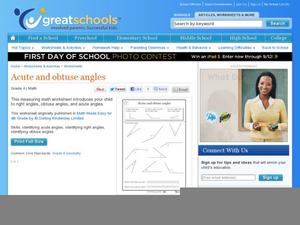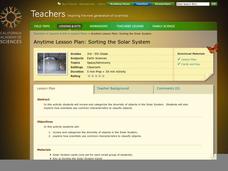Curated OER
Fruits and Vegetables
Here is a fun way to investigate fruits and vegetables. In this healthy diet and reading lesson, learners read and recite several poems about fruits and vegetables. They sort pictures and word cards with assorted names of fruits and...
Curated OER
Acute and Obtuse Angles
Take a look at these angles: What kind are they? Give mathematicians practice identifying obtuse, acute, and right angles in this categorizing activity. Each type is pictured and explained at the top, and scholars examine nine sample...
American Statistical Association
Candy Judging
Determine the class favorite. The statistics lesson plan has pupils collect, display, and analyze data. Pairs rank four kinds of candy based on their individual preferences. Working as an entire class, learners determine a way to display...
Howard Hughes Medical Institute
Sorting Finch Species
Don't just tell your class about Darwin's finches ... show them! Sort some of science's most famous birds using an interactive lesson. Learners try their hand at classifying finches using song, sonogram, and beak appearance, as well as...
Curated OER
Sorting in More than One Way
Sorting, categorizing, and classifying are skills learners must master for many different reasons. The class will work in small groups to list, classify, and sort a stack of familiar books. The neat part about the instructional activity...
Curated OER
Classifying Rocks
A well-designed lesson plan on rock classification awaits you. In it, fifth graders are divided into groups. Each group is given a box of rocks which they must sort into two categories. They use the "Rock 'n Roll Rule," in making their...
Discovery Education
Clutter Cutter
Challenge young learners to cut the clutter with this fun engineering project. As employees of a home and office supply company, young engineers are asked to develop devices that organize everyday items. After participating in a...
EngageNY
More Examples of Functions
Discrete or not discrete? Individuals learn about the difference between discrete and non-discrete functions in the fourth installment of a 12-part module. They classify some examples of functions as being either discrete or non-discrete.
Curated OER
Classification of Animals
First graders investigate the characteristics of vertebrates. They classify each as mammal, fish, bird, and reptiles. Students explore the differences between various types of animals and classify each.
Curated OER
Lesson 1: Hot, Not, or Silly
Students discover burn prevention and fire safety while sorting and classifying related pictures. In this early childhood lesson plan, students identify ways to prevent burns, and discuss various ways in which burns may occur. Students...
Curated OER
Creating and Outline From Research
Fourth graders develop 3 research questions about a topic they choose and categorize the information they have learned. In this research lesson plan, 4th graders use a variety of non fiction materials from the library.
Curated OER
Three Little Pigs: Human, Natural and Capital Resources
First and second graders will learn about natural, capital , and human resources through the story The Three Little Pigs. They will listen to the story, write down what they know about straw, wood, and brick, then complete a chart...
Curated OER
The Pronunciation of the Past Simple and Past Participle of Regular Verbs
In this words with -ed endings worksheet, learners put words with -ed endings into categories. Students classify 33 words into 3 separate categories.
Curated OER
Tool Shop
Students learn how tools help us accomplish things. In this tool discovery lesson, students review the function of tools. They then make a class chart and categorize different types of tools found in the classroom. Finally, they create a...
Curated OER
Identify, Sort, Classify
Students improve their identifying, sorting, and classifying skills. In this categorizing lesson, students use cubes to practice their sorting, classifying, and identification skills.
Alabama Learning Exchange
Classification
Students examine why scientists classify living organisms. They list and classify items they buy at the grocery store, sort and classify leaves, explore various websites, and write a biography of Carolus Linnaeus.
Curated OER
Bug Sweep
Students observe and categorize insects. In this insects science lesson, students create a bug catcher out of a coat hanger and plastic bag, then collect bugs from the schoolyard. Students count and categorize the insects according to...
Mathematics Assessment Project
Solving Linear Equations in One Variable
A thorough and professional appearance characterizes a lesson on linear equations. Maturing mathematicians are taught to identify and exemplify linear equations with a single variable. They also classify equations according to the number...
Curated OER
Answering a Research Question
Students explore beginning research skills. In this nonfiction comprehension and research lesson, students generate possible research questions to answer when given the book title of Animals of the Sea and Shore by Ann O. Squire....
Curated OER
Trash Talkin'
Students analyze classroom solid waste. In this environmental lesson, students weight and categorize classroom waste over a one week period. Students examine ideas on how to limit the amount of waste.
Curated OER
What Does Not Belong? (Groups of Pictures)
In this categorizing pictures learning exercise, students analyze four sets of pictures. Each set has three objects that go together and one that does not belong. Students circle the picture that does not go with the others.
Curated OER
Save the Music Concerts: Parts 1 & 2
Music aficionados classify pop music into by musical genres or styles. They evaluate the positive and negatives of collaborative performances, view segments of VH1's "Save the Music" concert, and discuss the difficulties of...
Carolina K-12
Factors of Production and Economic Decision-Making
Class members begin this engaging economics activity by listing all the resources used in producing a car and using that example to draw parallels to the four primary factors of production: capital goods, labor, natural resources, and...
California Academy of Science
Sorting the Solar System
Scientists are always sorting and classifying objects based on their characteristics. In a hands-on learning activity, young space explorers work together to categorize solar system cards based on their properties. It is up to the...
Other popular searches
- Categorize and Classify
- Reading Classify Categorize
- Classify Categorize Animals
- Classify and Categorize Math























